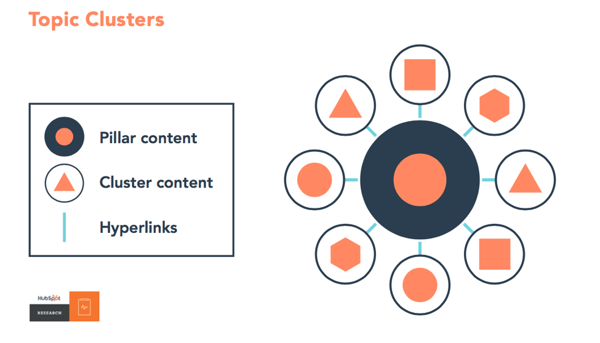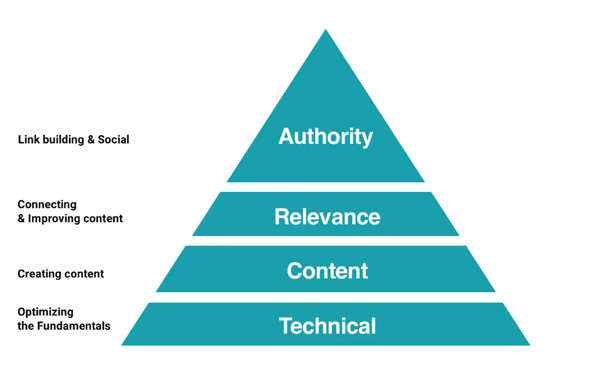
Since we work with IT managed service provider clients, we understand the frustration associated with competitors appearing at the top of the search implementation results page. It's never a good feeling when they're dominating the digital market.
If you want to market your IT MSP business online, now is the time to start thinking more strategically about SEO. If you Google this term, it might seem like a pile of information that you don't have time to look through. So, we've broken it down into 3 best practices and practical tips to help your MSP.
This article explains:
- Different approaches to SEO that IT service providers can adopt
- Why SEO matters to IT MSPs
- How IT MSPs create useful content
- Helpful tips for on-page optimization, local SEO reviews, and more
Let's take a closer look at the first proven best practice.
Best Practice #1: Use a topic cluster model
Prospective customers aren't using search engines the way they did decades ago. The reason for this is, in large part, that Google is now smart enough to understand intentions. The IT MSP sector's approach to SEO must reflect this new search method. And it starts with the popular SEO topic.
What is trending SEO?
 Source: HubSpot
Source: HubSpot
In this model, a single “pillar” page acts as the center of comprehensive topic content. For IT MSPs, this page focuses on highly competitive and frequently searched keywords such as IT compliance, cybersecurity, and managed IT services.
In that case, cluster content is usually an article or landing page that targets keywords related to the topic. Since these aren't searched that often, they're usually less competitive. In the cybersecurity topic example, one of the cluster keywords might be “cybersecurity solutions for small businesses.”
Link service pages, articles, and pillar pages to signal to Google and other search engines that your website is an authority on this topic and deserves the top spot.
Why is SEO important for IT MSPs?
People don't buy services the same way they did decades ago. Businesses are beginning to realize that potential buyers want to learn everything they can do themselves before they even think about talking to a salesperson. In fact, 45% of B2B buyers conduct their own research online and offline before making a decision.
The key is to build trust before speaking to anyone on the sales team.
SEO provides buyers with detailed information on how to solve challenges, such as how to protect employees from cyber attacks. The best case scenario is for buyers to search for common questions, such as how to back up an organization's data to the cloud, and then find an article on the website that answers that question.
This increases authority and increases trust in the business by showing that you know how to best serve customers. The more keywords you rank for, the more likely potential customers are to find an MSP, and customers will trust that you are IT savvy.
Wondering why your MSP isn't ranked on Google? Read this article to avoid common mistakes.
How can IT MSPs enter the market with a trending SEO strategy?
Aspire has helped multiple IT MSPs build a successful SEO foundation. You can apply the same framework to your own business. Start by digging deeper into the buyer persona. This allows us to truly understand our customers' concerns and brainstorm what they're searching for online.
In the IT MSP space, this persona could be a CIO dissatisfied with the current IT MSP or an IT manager with competing urgent priorities. In this persona exercise, our team will also perform a technical SEO audit. This will detect any serious technical errors that need to be fixed in order to send a signal to Google that the website is not spam.

Next, begin keyword research. List your services and key trends your audience is likely to search for, and use keyword research tools to determine how often those keywords are being used (and how competitive they are). This will display a list of topics (columns) and associated keywords.
Keyword research tip: There's no limit to how many keywords you can include per pillar, but it's a good idea to start with 8 to 10 keywords per topic.
Now you can associate these keywords with content you can actually create, such as articles, white papers, and e-books. If you're stuck with content that's actually useful to your prospects, take a look at what IT MSP competitors are creating for content. Next, create a list containing all of the following:
- What questions are your competitors answering?
- What megatrends are trending?
- When I type a keyword into Google, what related topics appear in the dropdown?
- Are there questions your sales team asks that aren't answered on the website?
This is how you can create a useful, SEO-optimized content strategy and attract website visitors from the top of the funnel. Aim to publish at least one of these blogs per month. You can also create SEO-optimized case studies for prospects who are about to make a purchase.
Once that content is published, you'll want to start a backlink strategy centered around the pillar page, that is, a page containing links and content from every sub-article you've created. Backlinks are one of the most important metrics for Google to determine that content is reliable, accurate, and relevant.
You can ask freelancers for backlinks, but they can also be expensive. Instead, you can contact journalists to write original articles, add businesses to directories, and insist on unlinked mentions of brands. Set up Google Alerts for your brand, wait for notifications to arrive, and check if they're properly linked to your website. If a link isn't set up, contact that site to set up a backlink.
Tip for optimizing current content: If your site already has content, analyze articles that closely match your new keyword list. You can optimize your article by mentioning the keyword 4 to 5 times (if the article is about 1000 words), linking to 3 other website pages, adding meta descriptions, and including keywords in the alternative text for images.
Best Practice #2: Use Local SEO
This strategy is a good starting point for a local SEO approach, but what about ITMSPs that want to enter the market through regional cities or states, or vertical market segments?
First, we'll conduct keyword research on local keywords that prospects use on Google. You can explore Google Search Console to see what local or industry-related phrases your IT MSPs are showing, or use tools like Semrush to see how competitive local or vertical terms are and whether your competitors rank for those keywords.
List these keywords in an Excel spreadsheet and prioritize which ones to start with. If you want to work on both strategies simultaneously, you can use either one locally or one vertically. Targeting a few SEO priorities at once is far more effective, so I recommend this approach rather than tackling many areas of focus at once.
Start by creating one blog post per month that answers questions about specific regional or industry-specific keywords that aren't meant for promotion. Remember, the purpose of this blog is to answer viewers' questions while showcasing technical knowledge, not to get them to contact you. Trust that your viewers will come to you when you're ready.
When creating local content, be sure to optimize your Google My Business account for where you live. Start by filling out all the fields and adding your local blog post to your account once it's written.
Tips for boosting local SEO: Local reviews are essential for increasing local SEO awareness. Create personalized email campaigns for existing customers and politely ask them to leave Google reviews.
Best Practice #3: Measure what's working (and what's not)
To understand keyword rankings, it's a good idea to use a simple Excel sheet where you record the local, topic, or vertical market keywords you want to rank. Monthly updates are not a big advantage, and since current and past rankings can be visualized, the long-awaited visibility can be obtained.
Use Google Search Console to check what users are searching for and what they're showing on your website (called impressions) when publishing content. What pages are users clicking on? Measure organic website traffic through HubSpot or Google Analytics. If one topic or page is trending higher than others, increase the amount of content on that topic.
SEO is a marathon, not a sprint, so it can take months for visible implementation results to appear. Keep in mind that Google frequently releases core updates that change how its algorithm ranks website pages, which may affect keyword rankings.
Now is the time for IT MSPs to take the first page.
Developing a successful inbound marketing strategy is no easy feat. But if you follow these best practices and helpful tips, you'll be well on your way to developing a basic IT MSP marketing strategy.
Here are the main points in this article.
- Whether your target is topical, local, or vertical SEO keywords, you need to utilize SEO.
- By creating useful IT content, you can align SEO best practices and educate your audience along the buyer journey.
- Use useful tools to measure progress and match content with business results.
Don't rely on “random marketing practices” for MSPs to get more leads. There are people asking technical questions they know the answer to. All you need to do is strategically place that content on your website.
If IT MSPs need help getting on Google's first page, see why other MSPs choose to partner with Google's fractional marketing department.



0 comments